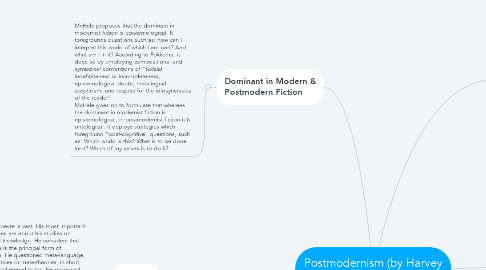
1. Dominant in Modern & Postmodern Fiction
1.1. McHale proposes that the dominant in modernist fiction is epistemological. It foregrounds questions such as: how can I interpret this world of which I am part? And what am I in it? According to Fokkema, it does so by employing compositional and syntactical conventions of “textual indefiniteness or incompleteness, epistemological doubt, metalingual skepticism, and respect for the idiosyncrasies of the reader” McHale goes on to formulate that whereas the dominant in modernist fiction is epistemological, in postmodernist fiction it is ontological. It deploys strategies which foreground “post-cognitive” questions, such as: Which world is this? What is to be done inint? Which of my selves is to do it?
2. Foucault
2.1. Foucault’s oevre is vast. His most important contributions are about his studies on power and knowledge. He considers that knowledge is the principal form of production. He questioned meta-language, meta-narratives or meta-theories, in short, universal and eternal truths. He proposed that “there is an intimate relation between the systems of knowledge which codify techniques and practices for the exercise of social control and domination within particular localized contexts.” Foucault influenced -and continues to do so- many fields, but mostly minorities such as feminist, gays, ethnic groups, etc.
3. Derrida
3.1. Jacques Derrida is said to be the father of the theory of deconstruction. This theory claims that it is vain to try to master a text because of the perpetual interweaving of texts and meaning is beyond our control. Derrida considers ‘collage/montage’ as the primary form of postmodern discourse. The producer and the consumer, or the writer-reader both participate in the production of meaning, which is never univocal or stable. Writers create texts do so in accordance with other texts or words they have encounter, and the readers do the same thing. This intertextuality has a life of its own, since ‘language works through us’.
4. Lyotard
4.1. Lyotard argues that the social bond is linguistic, but not woven with a single thread, rather an indeterminate number of language games. Each individual living in an intersection of many of these. He suggest that people resort to a certain code depending on the situation they find themselves in. Lyotard considers that postmodern thought is set in the heart of what he sees as a ‘dramatic social and political transition in the languages of communication in advanced capitalist societies’. He believes that modernism has changed because the ‘technical and social conditions of communication have changed’. In consequence, much like Foucault, he places knowledge as a principal force of production.
5. Hassan
5.1. Deconstruction of the term 'Postmodernism'
5.1.1. Hassan emphasises the prefix and suffix of the term. He indicates that the suffix “ism” denotes an organised system, a poetics and the prefix “post” points to something that comes after the modernist movement.
5.2. characterization of Postmodernism
5.2.1. “A poetics which is the successor of, or possibly a reaction against, the poetics of early twentieth-century modernism, and not some hypothetical writing of the future” In this case it is not clear if that’s the writer’s opinion or Hassan’s. Earlier in the text, he says that Hassan describes postmodernism as “a stage on the road to the spiritual unification of humankind”.
5.3. Differences between Modernism / Postmodernism
5.3.1. Hassan lines a series of stylistic oppositions between modernism and postmodernism. Although his oppositions are about different fields, such as anthropology, architecture, political science, etc. The ones ‘relevant’ to literature are: Romanticm/symbolism in modenrism, paraphysics /Dadaism in postmodernism. Form / antiform, creation / decreation-deconstruction, narrative-grand histoire / petite histoires, art object-finished work / process, gender-boundary / text- intertext.
